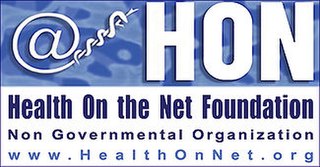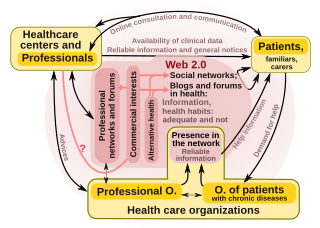Related Research Articles

A blog is an informational website published on the World Wide Web consisting of discrete, often informal diary-style text entries (posts). Posts are typically displayed in reverse chronological order so that the most recent post appears first, at the top of the web page. Until 2009, blogs were usually the work of a single individual, occasionally of a small group, and often covered a single subject or topic. In the 2010s, "multi-author blogs" (MABs) emerged, featuring the writing of multiple authors and sometimes professionally edited. MABs from newspapers, other media outlets, universities, think tanks, advocacy groups, and similar institutions account for an increasing quantity of blog traffic. The rise of Twitter and other "microblogging" systems helps integrate MABs and single-author blogs into the news media. Blog can also be used as a verb, meaning to maintain or add content to a blog.
In a support group, members provide each other with various types of help, usually nonprofessional and nonmaterial, for a particular shared, usually burdensome, characteristic. Members with the same issues can come together for sharing coping strategies, to feel more empowered and for a sense of community. The help may take the form of providing and evaluating relevant information, relating personal experiences, listening to and accepting others' experiences, providing sympathetic understanding and establishing social networks. A support group may also work to inform the public or engage in advocacy.
A virtual community is a social network of individuals who connect through specific social media, potentially crossing geographical and political boundaries in order to pursue mutual interests or goals. Some of the most pervasive virtual communities are online communities operating under social networking services.
An online community, also called an internet community or web community, is a community whose members interact with each other primarily via the Internet. Members of the community usually share common interests. For many, online communities may feel like home, consisting of a "family of invisible friends". Additionally, these "friends" can be connected through gaming communities and gaming companies. Those who wish to be a part of an online community usually have to become a member via a specific site and thereby gain access to specific content or links.

Health On the Net Foundation (HON) is a Swiss not-for-profit organization based in Geneva which promotes a code of conduct for websites providing health information and offers certificates to those in compliance.
The social web is a set of social relations that link people through the World Wide Web. The social web encompasses how websites and software are designed and developed in order to support and foster social interaction. These online social interactions form the basis of much online activity including online shopping, education, gaming and social networking services. The social aspect of Web 2.0 communication has been to facilitate interaction between people with similar tastes. These tastes vary depending on who the target audience is, and what they are looking for. For individuals working in the public relation department, the job is consistently changing and the impact is coming from the social web. The influence held by the social network is large and ever changing.
eHealth describes healthcare services which are supported by digital processes, communication or technology such as electronic prescribing, Telehealth, or Electronic Health Records (EHRs). The use of electronic processes in healthcare dated back to at least the 1990s. Usage of the term varies as it covers not just "Internet medicine" as it was conceived during that time, but also "virtually everything related to computers and medicine". A study in 2005 found 51 unique definitions. Some argue that it is interchangeable with health informatics with a broad definition covering electronic/digital processes in health while others use it in the narrower sense of healthcare practice using the Internet. It can also include health applications and links on mobile phones, referred to as mHealth or m-Health.

Web 2.0 refers to websites that emphasize user-generated content, ease of use, participatory culture and interoperability for end users.
Internet identity (IID), also online identity, online personality or internet persona, is a social identity that an Internet user establishes in online communities and websites. It may also be an actively constructed presentation of oneself. Although some people choose to use their real names online, some Internet users prefer to be anonymous, identifying themselves by means of pseudonyms, which reveal varying amounts of personally identifiable information. An online identity may even be determined by a user's relationship to a certain social group they are a part of online. Some can be deceptive about their identity.
Cyberchondria, otherwise known as compucondria, is the unfounded escalation of concerns about common symptomology based on review of search results and literature online. Articles in popular media position cyberchondria anywhere from temporary neurotic excess to adjunct hypochondria. Cyberchondria is a growing concern among many healthcare practitioners as patients can now research any and all symptoms of a rare disease, illness or condition, and manifest a state of medical anxiety.
A personal health record (PHR) is a health record where health data and other information related to the care of a patient is maintained by the patient. This stands in contrast to the more widely used electronic medical record, which is operated by institutions and contains data entered by clinicians to support insurance claims. The intention of a PHR is to provide a complete and accurate summary of an individual's medical history which is accessible online. The health data on a PHR might include patient-reported outcome data, lab results, and data from devices such as wireless electronic weighing scales or from a smartphone.

User-generated content (UGC), alternatively known as user-created content (UCC), is any form of content, such as images, videos, text, testimonials, and audio, that has been posted by users on online platforms such as social media, discussion forums and wikis. It is a product consumers create to disseminate information about online products or the firms that market them.

Social media are interactive technologies that facilitate the creation and sharing of information, ideas, interests, and other forms of expression through virtual communities and networks. While challenges to the definition of social media arise due to the variety of stand-alone and built-in social media services currently available, there are some common features:
- Social media are interactive Web 2.0 Internet-based applications.
- User-generated content—such as text posts or comments, digital photos or videos, and data generated through all online interactions—is the lifeblood of social media.
- Users create service-specific profiles for the website or app that are designed and maintained by the social media organization.
- Social media helps the development of online social networks by connecting a user's profile with those of other individuals or groups.
An edublog is a blog created for educational purposes. Edublogs archive and support student and teacher learning by facilitating reflection, questioning by self and others, collaboration and by providing contexts for engaging in higher-order thinking. Edublogs proliferated when blogging architecture became more simplified and teachers perceived the instructional potential of blogs as an online resource. The use of blogs has become popular in education institutions including public schools and colleges. Blogs can be useful tools for sharing information and tips among co-workers, providing information for students, or keeping in contact with parents. Common examples include blogs written by or for teachers, blogs maintained for the purpose of classroom instruction, or blogs written about educational policy. Educators who blog are sometimes called edubloggers.
An e-patient is a health consumer who participates fully in his/her medical care, primarily by gathering information about medical conditions that impact them and their families, using the Internet and other digital tools. The term encompasses those who seek guidance for their own ailments and the friends and family members who go online on their behalf. E-patients report two effects of their health research: "better health information and services, and different, but not always better, relationships with their doctors."
Online health communities are online social networks related to health. They primarily provide a means for patients and their families to learn about illnesses, to seek and offer social support, and to connect with others in similar circumstances. These online groups can be composed of individuals with illnesses, groups of medical professionals with shared interests, non-professional caregivers and family of patients, or a combination. The term "online health community" is primarily academic jargon.

"Health 2.0" is a term introduced in the mid-2000s, as the subset of health care technologies mirroring the wider Web 2.0 movement. It has been defined variously as including social media, user-generated content, and cloud-based and mobile technologies. Some Health 2.0 proponents see these technologies as empowering patients to have greater control over their own health care and diminishing medical paternalism. Critics of the technologies have expressed concerns about possible misinformation and violations of patient privacy.
Media monitoring is the activity of monitoring the output of the print, online and broadcast media. It is based on analyzing a diverse range of media platforms in order to identify trends that can be used for a variety of reasons such as political, commercial and scientific purposes.

Social media marketing is the use of social media platforms and websites to promote a product or service. Although the terms e-marketing and digital marketing are still dominant in academia, social media marketing is becoming more popular for both practitioners and researchers. Most social media platforms have built-in data analytics tools, enabling companies to track the progress, success, and engagement of ad campaigns. Companies address a range of stakeholders through social media marketing, including current and potential customers, current and potential employees, journalists, bloggers, and the general public. On a strategic level, social media marketing includes the management of a marketing campaign, governance, setting the scope and the establishment of a firm's desired social media "culture" and "tone."

Health information on the Internet refers to all health-related information communicated through or available on the Internet.
References
- ↑ Kovic, Ivor; Lulic, Ileana; Brumini, Gordana (2008). "JMIR—Examining the Medical Blogosphere: An Online Survey of Medical Bloggers". Journal of Medical Internet Research. 10 (3): e28. doi: 10.2196/jmir.1118 . PMC 2626433 . PMID 18812312.
- ↑ Boulos, MNK; Maramba, I; Wheeler, S (2006). "Wikis, blogs and podcasts: a new generation of Web-based tools for virtual collaborative clinical practice and education". BMC Med Educ. 6 (1): 41. doi: 10.1186/1472-6920-6-41 . PMC 1564136 . PMID 16911779.
- ↑ http://www.defense.gov/transformation/articles/2006-06/ta062906b.html . Retrieved April 13, 2012.
{{cite web}}: Missing or empty|title=(help) - ↑ Rodrigues, R (2000). "Ethical and Legal Issues in Interactive Health Communications: A Call for International Cooperation". J Med Internet Res. 2 (1): E8. doi: 10.2196/jmir.2.1.e8 . PMC 1761840 . PMID 11720927.
- ↑ "Uses of Blogs | Snurblog" . Retrieved April 13, 2012.
- ↑ McKenzie HM. Why Bother Blogging? Motivations for Adults in the United States to Maintain a Personal Journal Blog [master's thesis]. Raleigh, NC: North Carolina State University; 2008 65pp.
- ↑ Herring, S. C., Scheidt, L. A., Bonus, S., & Wright, E. (2004). Bridging the Gap: A Genre Analysis of Weblogs. In Proceedings of the Thirty-Seventh Hawaii International Conference on System Sciences (HICSS-37) (Ed.), Los Alamitos: IEEE Press.
- 1 2 Liu, SH; Liao, HL; Zeng, YT (2007). "Why people blog: an Expectancy Theory analysis". Issues in Information Systems. 8: 232–237.
- ↑ Blood, R. (2002). Weblogs: A history and perspective. In J. Rodzvilla (Ed.), We've Got Blog: How Weblogs are Changing Our Culture (pp. 7–16). Cambridge MA: Perseus Publishing.
- ↑ Rains, Stephen A (2007). "Perceptions of Traditional Information Sources and Use of the World Wide Web to Seek Health Information: Findings from the Health Information National Trend Survey". Journal of Health Communication. 12 (7): 667–80. doi:10.1080/10810730701619992. PMID 17934943. S2CID 17926200.
- ↑ "MLA : For Health Consumers and Patients : Find Good Health Information" . Retrieved April 13, 2012.
- ↑ "Blogs and Wikis – Use Blogs and Wikis to Do Health and Medical Research" . Retrieved April 13, 2012.
- ↑ (PDF) http://www.burstmedia.com/pdf/2008_06_01.pdf . Retrieved April 13, 2012.
{{cite journal}}: Cite journal requires|journal=(help); Missing or empty|title=(help) - ↑ (PDF) http://www.burstmedia.com/pdf/2007_08_01.pdf . Retrieved April 13, 2012.
{{cite journal}}: Cite journal requires|journal=(help); Missing or empty|title=(help) - ↑ Kalichman, Seth C.; Weinhardt, Lance; Benotsch, Eric; DiFonzo, Kari; Luke, Webster; Austin, James (2002). "Internet Access and Internet Use for Health Information Among People Living with HIV/AIDS". Patient Education and Counseling. 46 (2): 109–16. doi:10.1016/s0738-3991(01)00134-3. PMID 11867240.
- ↑ (PDF) http://www.burstmedia.com/pdf/2005_03_01.pdf . Retrieved April 13, 2012.
{{cite journal}}: Cite journal requires|journal=(help); Missing or empty|title=(help) - ↑ Kamel Boulos, Maged N.; Wheeler, Steve (2007). "The Emerging Web 2.0 Social Software: An Enabling Suite of Sociable Technologies in Health and Health Care Education". Health Information & Libraries Journal. 24 (1): 2–23. doi: 10.1111/j.1471-1842.2007.00701.x . PMID 17331140.
- ↑ Cui, Nan; Wang, Tao; Xu, Shuang (2010). "The Influence of Social Presence on Consumers' Perceptions of the Interactivity of Web Sites". Journal of Interactive Advertising. 11 (1): 36–49. doi:10.1080/15252019.2010.10722176. S2CID 143560156.
- ↑ Waters, Richard D (2007). "Nonprofit Organizations Use of the Internet: A Content Analysis of Communication Trends on the Internet Sites of the Organizations on the Philanthropy 400". Nonprofit Management & Leadership. 18 (1): 59–76. doi:10.1002/nml.171.
- ↑ "Impact of direct-to-consumer advertising on drug use varies depending on the drug, scope of advertising, and culture". Archived from the original on July 23, 2012. Retrieved April 13, 2012.
- ↑ Scott, David M. (2010), The New Rules of Marketing and PR: How to Use Social Media, Blogs, News Releases, Online Video, and Viral Marketing to Reach Buyers Directly. Hoboken, NJ: John Wiley & Sons.
- ↑ Eisingerich, Andreas B.; Kretschmer, Tobias (2008). "In E-Commerce, More is More". Harvard Business Review 86 (March): 20–21.
- ↑ Dorfman, L; Wallack, L (1993). "Advertising health: the case for counter-ads". Public Health Rep. 108 (6): 716–26. PMC 1403454 . PMID 8265756.
- ↑ Thorbjørnsen, Helge; Supphellen, Magne; Nysveen, Herbjørn; Egil Pedersen, Per (2002). "Building Brand Relationships Online: A Comparison of Two Interactive Applications". Journal of Interactive Marketing. 16 (3): 17–34. doi:10.1002/dir.10034. hdl: 11250/299131 . S2CID 53603898.